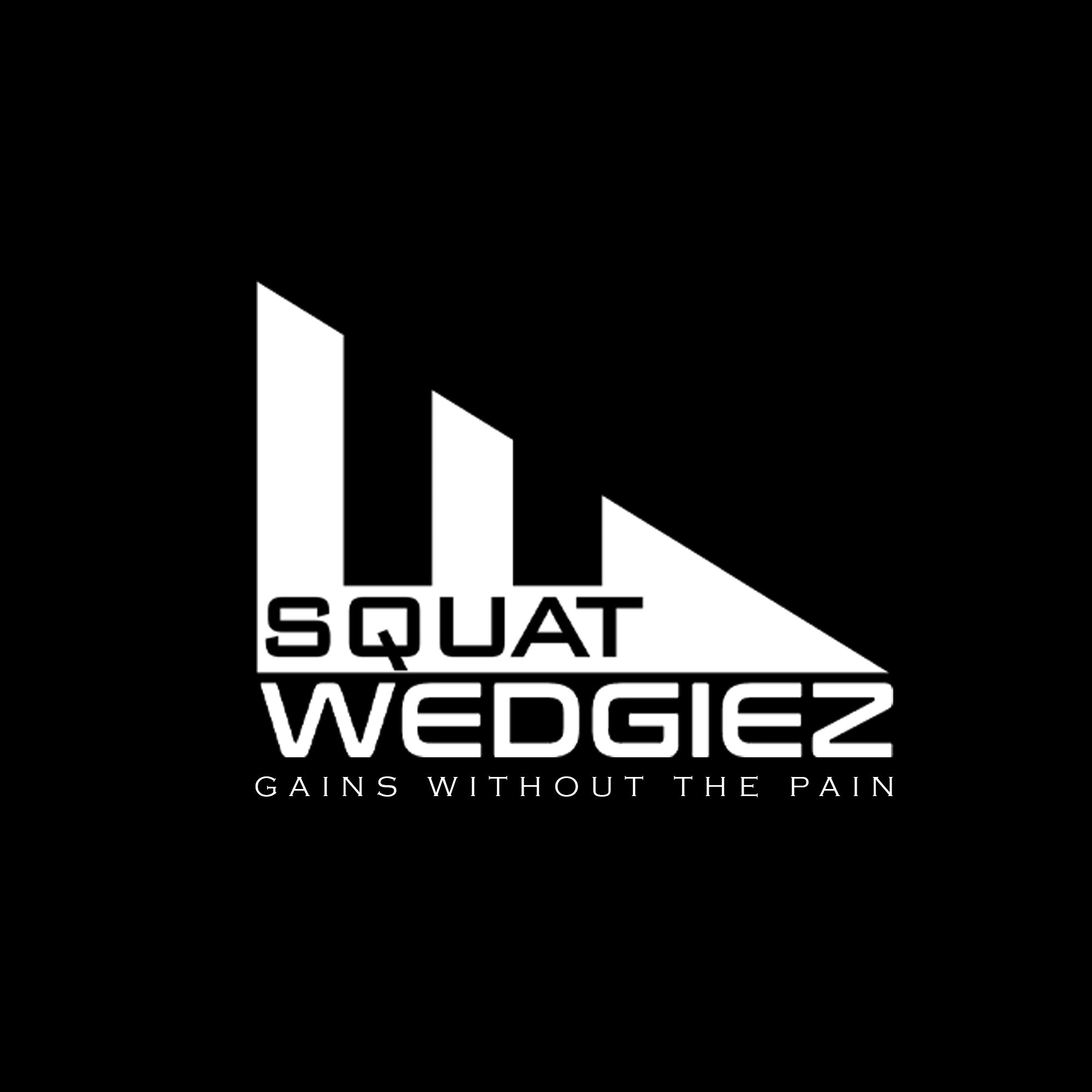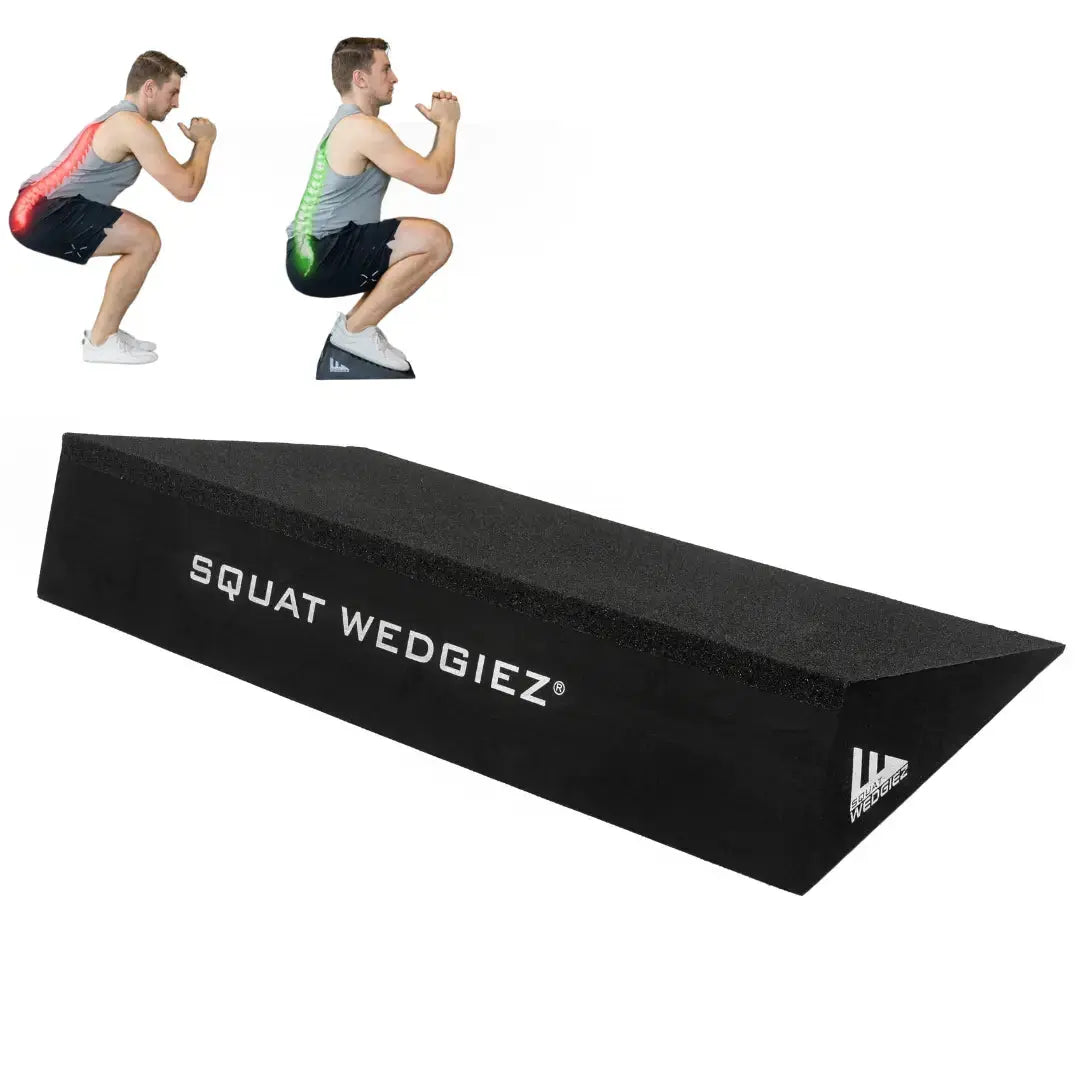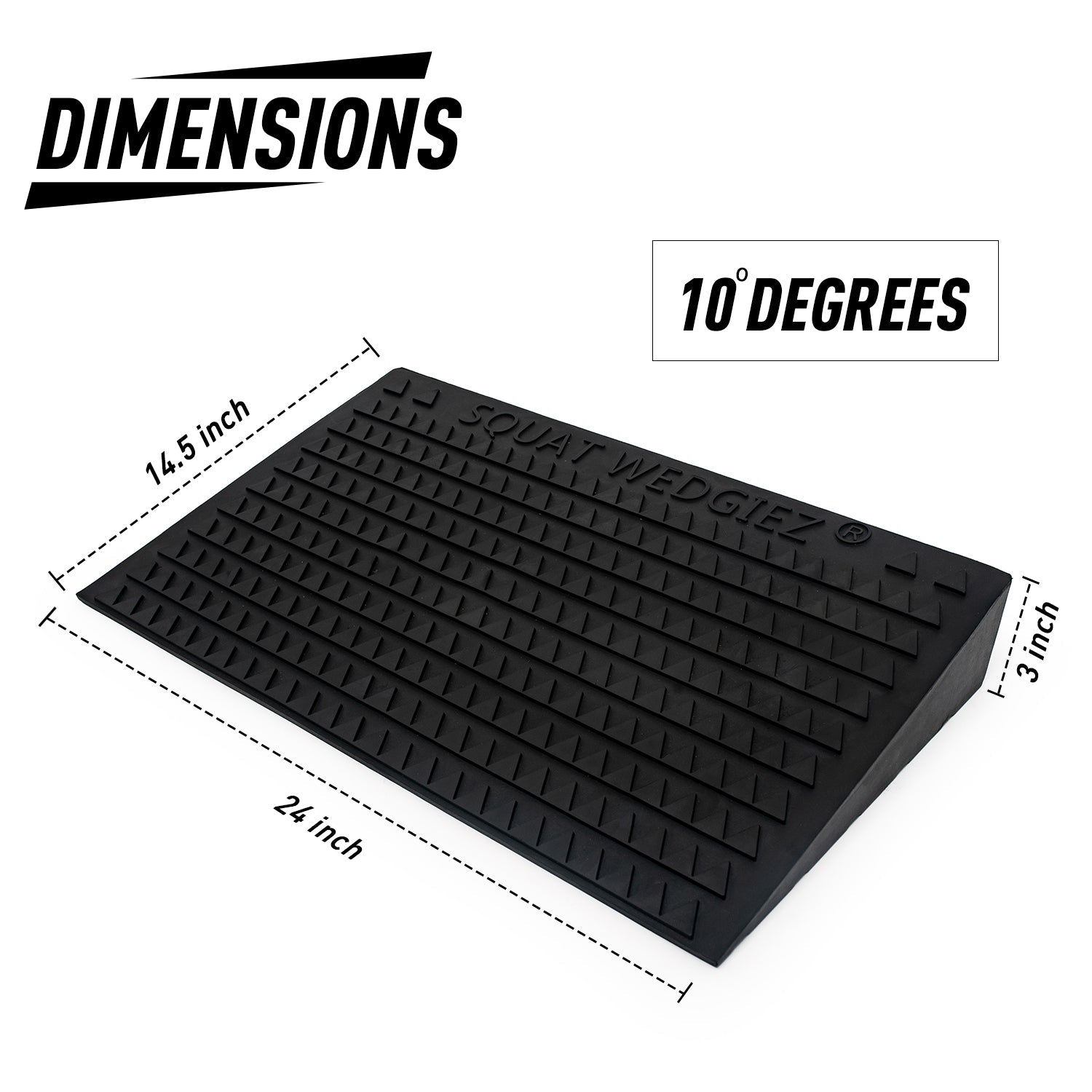Why Squat with Squat Wedges?
The barbell squat, a cornerstone of strength training, has long been the subject of intense debate regarding the impact of heel elevation. Some swear by it, others remain skeptical, and some get angry about it. A quick look at our Instagram comments would highlight those individuals who think I am biased because I founded SquatWedgiez.
However, Wedgiez has always been based on the latest science and my experiences as a personal trainer. So, to show the haters that heel elevation isn't a fad, I searched the interwebs for the latest research. And I came across two intriguing studies that shed light on the topic, unraveling the potential benefits and gender differences associated with heel-elevated squats.
Study #1: Comparing the kinematics of back squats performed with different heel elevations
The study involved 15 experienced recreational weightlifters who were randomly assigned to three conditions: barefoot, 25-mm wedges (1 inch), and 50-mm wedges (2 inches). The study's results were nothing short of remarkable. The analysis of the back squat movement revealed significant differences in trunk inclination and knee flexion between the three conditions. These findings have exciting implications for athletes and fitness enthusiasts looking to optimize their back squat technique and reap additional benefits.
1.Torso Stayed More Upright With Increasing Wedge Height
Participants experienced a more upright torso during the back squat than the barefoot group. The group using the steeper 2-inch wedges demonstrated the most upright trunk position. The increased trunk inclination observed with higher wedges suggests that squat wedges could be an effective tool for individuals with back pain or limited lumbar mobility. By promoting a more upright position, squat wedges may reduce strain on the lower back during squats.

2. Increased Knee Range of Motion
As the wedge height increased, the knee range of motion expanded significantly. Participants with the 2-inch wedges experienced greater knee flexion during the squat compared to the barefoot and 1-inch wedge conditions. The enhanced knee range of motion associated with using higher wedges indicates that squat wedges can be a valuable aid for individuals aiming to strengthen their knee joints and related muscles. This is particularly relevant for athletes seeking to improve knee stability and performance in various sports.
Study 2: Effect of Heel Lift Insoles on Lower Extremity Muscle Activation and Joint Work during Barbell Squats
The second study explored the effect squat wedges had on lower body muscle activation in the back squat. To delve deep into the matter, the research team recruited 20 healthy adult participants, evenly split between males and females, with varying squatting experience levels.
Muscle Activation Insights
With raised heels, key muscles, such as the vastus lateralis (quadricep), biceps femoris (hamstring), and gastrocnemius (calf), exhibited heightened activation. Simultaneously, muscle activation of the anterior tibialis (shin) decreased, offering valuable insights into which muscles are targeted during heel-elevated squats.

Impressive Ankle Work
The study demonstrated that when the subjects' heels were elevated, they experienced a significant increase in ankle work. This discovery implies that heel elevation may train the ankle more, making it an appealing technique for athletes with a history of ankle sprains or weakened joints.
Ankle Dorsiflexion Angle
Contrary to some assumptions, the research indicated that ankle dorsiflexion angles significantly decreased with elevated heels. This observation suggests that heel elevation may be particularly advantageous for individuals with limited ankle mobility, potentially reducing discomfort during the squats.
Gender Differences
An intriguing aspect of the study was the gender-specific outcomes. Male participants displayed a significant increase in knee flexion compared to hip flexion. On the other hand, female participants didn't show as much of a difference between the knees and hips.
So, Which Wedgie Should You Use?
In the initial study, researchers analyzed various heel elevations and discovered that the highest heel elevation caused the torso to be more upright and increased tension in the thigh muscles. While most squat wedges or slant boards are classified based on their slope angle instead of their height, we can assume that a higher heel elevation will lead to a steeper slope angle.
So a spectrum exists where a smaller wedge with a flatter slope, around 5 degrees, may cause more forward lean, emphasizing hip loading compared to a taller, steeper wedge. This nuanced adjustment can significantly impact squat depth and the distribution of tension, offering a tailored approach to individual needs and goals. A slope between 7-15 degrees is preferred by many as it strikes a balance between enhancing the squat pattern without undue stress on the knees and being versatile enough for other exercises like calf raises and hip thrusts.
However, those with limited mobility or a focus on thigh muscles may benefit more from a 20-degree slope as it ensures an upright torso and optimal engagement of the thigh muscles. Regardless of your slope angle, the key is to ensure whole-foot elevation, maintain proper biomechanics, and prevent excessive pressure on the toes. This holistic approach aligns with the foot's natural movement, ensuring safety and effectiveness across various squat depths and intensities.
When choosing a wedgie for your squats, it is important to consider your specific training goals, mobility, and body mechanics. The right wedgie can help alleviate back pain, improve knee health, and target specific muscle groups, ultimately leading to a healthier and more effective squat practice.
So, embrace the power of a wedgie and elevate your back squat performance to new heights. Whether you aim to strengthen your knees, alleviate back pain, or enhance your overall squatting technique, slant boards are the secret weapon you've been searching for in your fitness journey. Try one risk-free for 90 days by clicking the button below.
Citations
1. Monteiro, Pedro & Marcori, Alexandre & Nascimento, Vitor & Guimarães, Anderson & Okazaki, Victor. (2022). Comparing the kinematics of back squats performed with different heel elevations. Human Movement. 23. 10.5114/hm.2021.106164.
2. Lu Z, Li X, Xuan R, Song Y, Bíró I, Liang M, Gu Y. Effect of Heel Lift Insoles on Lower Extremity Muscle Activation and Joint Work during Barbell Squats. Bioengineering (Basel). 2022 Jul 8;9(7):301. doi: 10.3390/bioengineering9070301. PMID: 35877352; PMCID: PMC9312299.
Frequently Asked Questions
Find out answers to common questions we receive about our slant boards, squat wedges, and tib bars.
We recommend you take the "Pick Your Wedgie Quiz" to determine which wedgie is best for you. Please click the title, “Pick Your Wedgie Quiz” in the header to try it.
Heel-elevated squats have been shown to improve your squat depth, reduce tension in your lower back, and target your thighs more than regular squats. When you elevate your heel with a slant board, you shift your center of mass backward, which gives your hips and ankles more space to perform the squat movement.
Also, if you struggle to keep your heels down while squatting, adding a squat wedge or slant board underneath them can teach you how to feel your heels. The feeling of the ground in contact with your heel will improve your balance and ankle mobility.
When the ankle dorsiflexes, the foot needs to pronate. The arch of your foot flattens slightly and the knee travels towards the toes.
Elevating your whole foot or heel on the slant board will allow this movement to happen optimally compared to heel elevation on a plate.
Weight plates leave gaps between your heel and the ground, which decreases your balance and places your weight on your toes.
If your goal is to perform full range of motion squats to strengthen your legs, than an angle between 10 to 15 degrees would work best.
When your goal is to strengthen your thighs and glutes, an angle between 5 to 10 degrees is better because it will make your squat more hip dominant compared to a higher slope squat.
If you have minimal hip and ankle mobility or wanted to target your thighs only, a 20-degree slant board works well. I don't see the need to go above 20 degrees because it will push your center of mass too far forward and not allow you to load your hips.
Generally speaking, squatting on a lower slope will require more hip and ankle mobility compared to a steeper slope. As the angle increases, your hips and torso will stay more upright, which will make it easier to squat to full depth. This will place more tension on your quadriceps. (read more)
Our Adjustable Wedgie is the best tool for the job because of its 20 degree slope and stability. At 24 pounds, it wont move when you push off of it. With a height of 4.5 inches, it gives you the perfect platform to train your glutes. Plus, it is 14 inches long so you can elevate your whole foot (learn more).
A slant board has been shown to improve one’s lower body workout by increasing the range of motion for certain exercises.
The most popular movement being the heel elevated squat followed by the forefoot elevated calf stretch.
In adddittion to these exercises, people use a slant board for heel elevated split squats, step downs, hip thrusts and plyometrics.
A slant board with a width of 24 inches should be wide enough to perform a hip distance or shoulder width squat.
Our Adjustable Wedgie is 24 inches wide and our SumoWedgie is 24 inches wide.
If neither of these options are wide enough, then we recommend you choose our pair of DUO Wedgiez to customize your stance to your needs.
Walk up your slant board so your toes are elevated. Once your whole foot is on the slant board, lean forward to intensify your stretch.
You can apply the same concept to stretch your wrists. Place your hands on the slant board with the heel of your wrist at the top and your fingertips going downhill. Press the heel of your wrist down and lean back slightly.
If you struggle to squat deeply because your heels keep coming up, than a slant board can help.
Elevating your heel with a squat wedge or slant board can help push your center of mass backward so that your heels don’t lift while squatting.
Write content to help your customers to better understand your products or policies.
Please click HERE to watch a video on our top five exercises for beginners.
The quadricep (thigh) muscle will be the primary muscle trained during a slant board or squat wedge heel elevated squat. The vastus lateralis, vastus intermedius, and vastus medialis (VMO) will be targeted the most, followed by the rectus femoris. The glutes will be a secondary muscle strengthened followed by your adductors (inner thighs).
Strengthening your tibialis anterior, the muscle located on the front of your lower leg, can provide several benefits.
These include improved ankle stability, better balance and coordination, reduced risk of shin splints, and enhanced performance in activities such as walking, running, and jumping.
Additionally, a strong tibialis anterior can help prevent common foot and ankle injuries and contribute to overall lower body strength and stability.
The best way to train your anterior tibialis is with our Versa Tib Bar.
A "tib raise," short for tibialis raise or tibialis anterior raise, primarily strengthens the tibialis anterior muscle.
The tibialis anterior is located on the front of the lower leg. It is responsible for dorsiflexion, which is the movement that brings the top of the foot towards the shin.
By performing tib raises, you can target and strengthen the tibialis anterior, which can help improve ankle stability, balance, and overall lower leg strength.
This exercise is particularly beneficial for athletes, runners, and individuals involved in activities that require strong lower leg muscles and ankle stability.
Shin splints, or medial tibial stress syndrome, occur when there's excessive stress on the shinbone and the tissues attaching muscles to the bone.
Loaded tibialis raises, performed with a tib bar, specifically target this area. By adding weight, this exercise not only strengthens the anterior tibilias but also puts controlled stress on the tibia, encouraging positive adaptive responses in the bone itself.
Similar to how weightlifting increases bone mineral density in the arms, legs, and spine, loaded anterior tibialis raises enhance the bone density of the tibia.
This exercise stimulates the bone remodeling process, where the bone tissue is gradually replaced with new, stronger tissue.
Over time, this process increases the overall density and thickness of the tibia, making it more resilient to the stresses of high-impact activities. (read more)
A Nordic bench is a piece of exercise equipment that allows you to perform a Nordic hamstring curl, which is a bodyweight exercise that targets your hamstrings, calves and lower back.
Research has shown that Nordic hamstring exercises were more effective in improving knee pain and stability after ACL reconstruction, and promoting the recovery of knee function.
The hamstrings are the primary muscle worked followed by the calves and low back.
Yes—when used correctly, a slant board can actually help reduce and prevent knee pain. By elevating your heels, it allows for a more upright squat, increasing quad activation and strengthening the muscles that support your knees. This builds resilience in tendons and ligaments, improves joint stability, and can help with conditions like patellar tendonitis (“jumper’s knee”). Always start with a comfortable angle and pain-free range of motion, and progress gradually.
Shipping & Returns
Find answers to commonly asked questions on shipping & returns
Do you offer free shipping?
Yes, on all orders shipped in the Continental US.
Do you ship overseas?
Yes, but we are not responisble for tax and duty costs.
How long will it take to get my orders?
Orders take 24 hours to process and will take 4-7 business days to arrive. Overseas deliveries can take anywhere from 7-16 days. Delivery details will be provided in your confirmation email.
What is your 90 day return policy?
You have 90 days to try our products risk free. If you aren't satisfied, please email erik@squatwedgiez.com.
You will receive a free shipping label to send back the product if you live in the Continental United States.
If you live outside of the Continental United States, you must pay the cost of shipping.
After inspection, we will give you a full refund if the product doesn't have any further damage.



